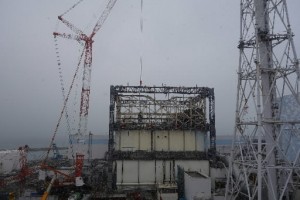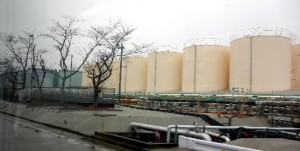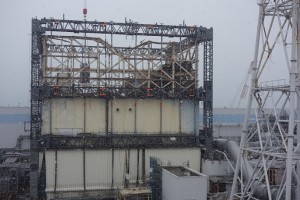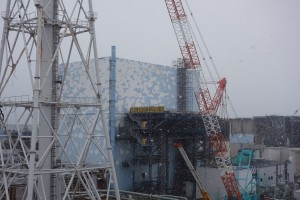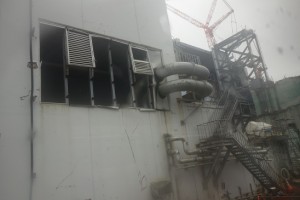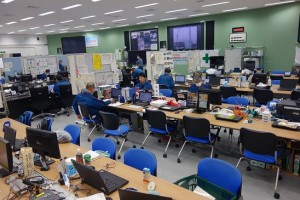Report from Fukushima No. 1 nuclear power plant: Long, rocky road to decommissioning reactors
Feb. 11, 2017
by Shigenobu Sakai, Staff Writer
Almost six years after it was devastated by a giant tsunami triggered by a powerful earthquake that hit northern Japan, the Fukushima No. 1 (Daiichi) nuclear power plant now looks like a huge construction site. Workers are struggling to decommission the reactors, a process that experts believe will take 40 years. Currently, work is being done to remove debris and treat contaminated water, which must be undertaken before actually removing nuclear fuel from the reactor buildings destroyed by hydrogen explosions. As one of the members of the delegation dispatched by the Japan National Press Club, I visited the power plant on February 9.
Stepping off the bus, I covered my mouth and nose with a dust mask. We walked in the snow, and when we reached a spot about 100 meters from the No. 1 reactor, I gasped. The crushed white steel framework of the reactor building was exposed. I could see a crane that had collapsed. An employee of the Tokyo Electric Power Company (TEPCO) explained that the building has been left as it was in the aftermath of the explosion.
In the upper part of the building, a giant crane was being used to hang special equipment to investigate the heap of debris, while smaller debris was being vacuumed out. This operation is done by remote control because of the high level of radiation.
TEPCO is trying to accelerate the removal of 1,573 fuel rods left in the spent fuel pools of the No. 1 to No. 3 reactors. The removal of debris at the No. 1 reactor will begin in the first half of this year with the goal of removing the 392 fuel rods there. According to the company’s plan, a reactor building cover, with equipment to remove the fuel rods, will be constructed from fiscal 2019, and the removal of the fuel rods will begin in fiscal 2020. The employee said that they will make use of the knowledge they acquired from working on the No. 3 reactor.
The No. 3 reactor is ahead of the other two in terms of decommissioning work, but this process is facing difficulty. Although debris has been removed from around the fuel pool, the level of radiation there has not gone down as much as expected. As a result, the start of work to remove the fuel rods has been delayed from fiscal 2017 to fiscal 2018. In most of the area, full face masks are not needed, but radiation levels around the reactor buildings are high. As we went between the No. 2 and No. 3 reactors by bus, the reading of the dosimeter jumped to 335 microsieverts per hour, which is more than five times the exposure dosage from a chest X-ray.
Site transformed into a “grove of tanks”
Looking out the window of the bus, I saw many large tanks that contain contaminated water and treated water. The employee said, “This area used to be a grove inhabited by wild birds.” But it has been transformed into a “grove of tanks,” where some 900 tanks now stand.
The amount of contaminated water continues to increase. This is due to the fact that around 150 tons of groundwater flow into buildings of the No. 1 to No. 4 reactors each day. TEPCO believes that an underground wall of frozen soil will be a key tactic in battling the problem of contaminated water. The 1.5 kilometer-long ice wall surrounding the four reactors is intended to prevent groundwater from entering the reactor buildings by freezing the ground. It is being created by embedding some 1,500 pipes about 30 meters beneath the ground. Silver pipes, through which flows refrigerant at a temperature of 30 degrees below zero, are surrounding the reactors.
“Moving forward, step by step”
But the complete freezing of the ground has not yet been realized. If the water level around the reactors plummets, the contaminated water can leak out from inside the reactors. Shunji Uchida, who heads up the power plant, said, “We are cautiously moving forward, little by little, step by step.”
But difficult problems still lie ahead. Tritium, a radioactive substance, cannot be removed even if contaminated water is treated at a special facility. Some 715,000 tons of water which contain tritium is stored in tanks, which is equivalent to 2,000 25-meter pools, and there is nowhere to dispose of it.
Then there will be the most difficult task of all: removing the nuclear fuel (fuel debris) which melted and dropped as a result of the core meltdown. It is said that the decommissioning project will take 40 years and cost 8 trillion yen, which has risen to four times the initial estimate. “Where are you if you compare your progress to climbing a mountain?” one reporter asked. In a strained voice, Mr. Uchida replied, “We have just begun to climb.”
(Originally published on February 11, 2017)
Almost six years after it was devastated by a giant tsunami triggered by a powerful earthquake that hit northern Japan, the Fukushima No. 1 (Daiichi) nuclear power plant now looks like a huge construction site. Workers are struggling to decommission the reactors, a process that experts believe will take 40 years. Currently, work is being done to remove debris and treat contaminated water, which must be undertaken before actually removing nuclear fuel from the reactor buildings destroyed by hydrogen explosions. As one of the members of the delegation dispatched by the Japan National Press Club, I visited the power plant on February 9.
Stepping off the bus, I covered my mouth and nose with a dust mask. We walked in the snow, and when we reached a spot about 100 meters from the No. 1 reactor, I gasped. The crushed white steel framework of the reactor building was exposed. I could see a crane that had collapsed. An employee of the Tokyo Electric Power Company (TEPCO) explained that the building has been left as it was in the aftermath of the explosion.
In the upper part of the building, a giant crane was being used to hang special equipment to investigate the heap of debris, while smaller debris was being vacuumed out. This operation is done by remote control because of the high level of radiation.
TEPCO is trying to accelerate the removal of 1,573 fuel rods left in the spent fuel pools of the No. 1 to No. 3 reactors. The removal of debris at the No. 1 reactor will begin in the first half of this year with the goal of removing the 392 fuel rods there. According to the company’s plan, a reactor building cover, with equipment to remove the fuel rods, will be constructed from fiscal 2019, and the removal of the fuel rods will begin in fiscal 2020. The employee said that they will make use of the knowledge they acquired from working on the No. 3 reactor.
The No. 3 reactor is ahead of the other two in terms of decommissioning work, but this process is facing difficulty. Although debris has been removed from around the fuel pool, the level of radiation there has not gone down as much as expected. As a result, the start of work to remove the fuel rods has been delayed from fiscal 2017 to fiscal 2018. In most of the area, full face masks are not needed, but radiation levels around the reactor buildings are high. As we went between the No. 2 and No. 3 reactors by bus, the reading of the dosimeter jumped to 335 microsieverts per hour, which is more than five times the exposure dosage from a chest X-ray.
Site transformed into a “grove of tanks”
Looking out the window of the bus, I saw many large tanks that contain contaminated water and treated water. The employee said, “This area used to be a grove inhabited by wild birds.” But it has been transformed into a “grove of tanks,” where some 900 tanks now stand.
The amount of contaminated water continues to increase. This is due to the fact that around 150 tons of groundwater flow into buildings of the No. 1 to No. 4 reactors each day. TEPCO believes that an underground wall of frozen soil will be a key tactic in battling the problem of contaminated water. The 1.5 kilometer-long ice wall surrounding the four reactors is intended to prevent groundwater from entering the reactor buildings by freezing the ground. It is being created by embedding some 1,500 pipes about 30 meters beneath the ground. Silver pipes, through which flows refrigerant at a temperature of 30 degrees below zero, are surrounding the reactors.
“Moving forward, step by step”
But the complete freezing of the ground has not yet been realized. If the water level around the reactors plummets, the contaminated water can leak out from inside the reactors. Shunji Uchida, who heads up the power plant, said, “We are cautiously moving forward, little by little, step by step.”
But difficult problems still lie ahead. Tritium, a radioactive substance, cannot be removed even if contaminated water is treated at a special facility. Some 715,000 tons of water which contain tritium is stored in tanks, which is equivalent to 2,000 25-meter pools, and there is nowhere to dispose of it.
Then there will be the most difficult task of all: removing the nuclear fuel (fuel debris) which melted and dropped as a result of the core meltdown. It is said that the decommissioning project will take 40 years and cost 8 trillion yen, which has risen to four times the initial estimate. “Where are you if you compare your progress to climbing a mountain?” one reporter asked. In a strained voice, Mr. Uchida replied, “We have just begun to climb.”
(Originally published on February 11, 2017)

